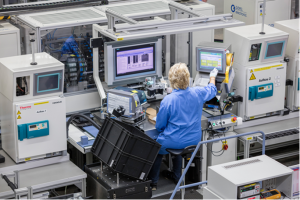Digitalization for Smarter Electronics Manufacturing

By Fram Akiki, Vice President, Electronics & Semiconductor Industry, Siemens PLM Software
The real and virtual worlds of electronics manufacturing are beginning to merge – the fourth Industrial Revolution or “Industry 4.0.” The idea of digital production has been widely adopted in the automotive industry, and by companies in industries such as machine tooling and printing, however, these are large enterprise companies with  global offices and production sites. Small and medium-sized companies have been slower to adopt digitalization technologies, but it’s imperative for them to apply digitalization solutions which have proven to be cost-effective and beneficial. Smart manufacturing for electronics eliminates physical prototypes, disconnected systems, paper-based work instructions, and silos of information to enable a continuous, integrated flow from design to planning to production.
global offices and production sites. Small and medium-sized companies have been slower to adopt digitalization technologies, but it’s imperative for them to apply digitalization solutions which have proven to be cost-effective and beneficial. Smart manufacturing for electronics eliminates physical prototypes, disconnected systems, paper-based work instructions, and silos of information to enable a continuous, integrated flow from design to planning to production.
Compared to current piece-meal digitalization strategies, a smart manufacturing methodology generates and distributes accurate, validated product and process models across the company, demonstrated at every stage of product development. Some key differences and advantages of digitalization include:
- More reliable and manufacturable designs
- Better collaboration among design, engineering, and manufacturing departments
- Less data redundancy
- Fewer shop-floor planning mistakes
- Less error-prone manual data entry
- Optimized inventory and JIT use of materials
- Enforced manufacturing best practices
- Accurate and up-to-date work instructions
- Plug-and-play data collection and key performance indicators (KPI) monitoring
- Fast time to root-cause identification
- Transition toward higher product mix without loss of factory performance
By digitalizing the entire product development process—from design to production—and connecting a digital thread through all the steps in between, the smart manufacturing for electronics strategy lets you know a design can be made, the manufacturing plan is up-to-date and synchronized, and the production system is optimized and performing as you planned it.
This information delivers significant competitive advantages over conventional, partially digitized approaches, including:
- Faster time-to-market and more frequent new product introductions
- Product development activities that used to take weeks are now done in hours when connected by a digital thread. Simulations and analyses performed on digital twins ensure right-first-time production. Overall, because a smart manufacturing strategy can reduce time-to-market by as much as 50%, it allows you to succeed in a market that demands frequent innovation.
Digitilization Enables Quality Improvements through Left-Shifting
Left-shifting refers to performing tasks that would normally occur later in the design process at an earlier stage. An example in electronics development is PCB design for manufacturing (DFM) analyses, which are performed early and regularly rather than waiting until the design is complete. Each time an analysis is performed, the overall design improves, and the greater the degree of the shift, the greater the benefit.
More Responsive Manufacturing
With a digital thread linking product design and manufacturing, planning can be performed earlier in development so by the time the design is complete, manufacturing can quickly follow. This opens the door to product customization and personalization.
Smarter Decision-making
More informed decisions are made possible by better visibility into manufacturing and the availability of analysis tools that fully exploit manufacturing data.
Cost Control
By improving the efficiency of your manufacturing processes and materials—at individual sites as well the global enterprise—the smart manufacturing for electronics strategy can help reduce overall manufacturing costs, ultimately keeping your products affordable for your consumers.
Proof of Concept
Siemens is the world’s leading supplier of programmable logic controllers (PLCs) and the Siemens Amberg Electronics Plant (Fig.1) is the company’s showcase plant for these systems. This plant manufactures 12 million PLCs per year, or one control unit every second, assuming 230 working days per year.
The Amberg operation is a successful example of Siemens’ Digital Enterprise platform in action. Using the smart manufacturing for electronics approach, the plant’s real and virtual manufacturing worlds are completely integrated. Product codes tell production machines what requirements they have and which production steps must be taken next. Products and machines determine which items on which production lines should be completed when to meet delivery deadlines. Independently operating software agents monitor each step to ensure compliance with regulations.

Figure 1: The Siemens Amberg facility is a prime example of advanced product automation and has received numerous awards. The Amberg factory already combines the real and virtual worlds: Products communicate with machines, and all production processes are optimally integrated and controlled via IT.
These practices rapidly turn innovation into products. Between the use of digital prototypes and the ability to simulate and optimize production processes in software, the time it takes for the Amberg plant to introduce new products is 50% lower than other Siemens PLC factories. Changeover time is half the time as well. New order lead-time is 24 hours, with the ability to handle a lot size of one.
Production quality at the plant is 99.99885%, and a series of test stations detect the few defects that do occur. This digital enterprise has seen cost savings as high as 25%.
What Might the Future Look Like?
Smart manufacturing for electronics is clearly capable of delivering competitive advantages in the current market climate in which fast new product introductions (NPIs), product personalization, and high quality requirements are predominant concerns.
But what about the future? If history is any indication, unforeseen market forces will pose their own product development challenges. In the near- to midterm, we see three technologies becoming more important, and we are working to make sure the smart manufacturing for electronics strategy will incorporate them.
Artificial Intelligence
There are hundreds of potential use cases for artificial intelligence (AI) in manufacturing, making this one of the most popular technologies amongst the global venture capital community. Capabilities that emanate from AI, called cognitive technologies, include computer vision, natural language processing, speech recognition, robotics, optimization, rules-based systems, planning and scheduling, and machine learning (the ability of machines to improve their performance by exposure to data). Siemens’ MindSphere harnesses factory floor IoT data to support machine learning.
Industrial 3D Printing
By 2020, 75% of manufacturing operations worldwide could be using 3D-printed tools, jigs, and fixtures for the production of finished goods. Some analysts predict that automotive and aerospace/defense will be the predominant users of this technology, and electronics manufacturing will adopt it to some extent. We have efforts underway, including a partnership with HP, to make sure this technology is as beneficial as possible to your manufacturing processes.
Advanced Robotics
Robots are now able to perform previously impossible electronics assembly operations. Siemens and partner ArtiMinds Robotics (Karlsruhe, Germany) are enabling a new level of flexible robot use, and are working toward the industrial application of robotic manipulation for smaller lot sizes and processes with significant variance.
Conclusion
Smart manufacturing for electronics is central to Siemens’ integrated platform that encompasses both PCB design and mechanical flows while uniting all of the domains required to engineer, manufacture, and deliver smart products for today and in the future. This digitalized development strategy encompasses everything from PCB design and factory-floor optimization to incorporating customer feedback into new designs (Fig. 2).

Figure 2: Siemens is focusing on ways in which industrial enterprises of all sizes can benefit from the digital transformation.
Smart manufacturing for electronics represents the new manufacturing operating model, adapted specifically for the needs of large to small- and medium-sized companies involved in electronics manufacture. We believe it is the most comprehensive platform currently available, and after deploying it in our own factory, we know it works.
Fram Akiki is Vice President, Electronics & Semiconductor Industry for Siemens PLM Software. He has over 30 years of experience in the electronics and semiconductor industry. Prior to joining Siemens, Fram was an executive for 12 years with Qualcomm in their chipset division and 21 years with IBM in their microelectronics group. Fram holds a B.S. in Electrical and Computer Engineering from Clarkson University and a M.S. in Electrical Engineering and a M.B.A. in International Business from The University of Vermont. He has authored a number of white papers, holds a patent on RFID/Cellular connectivity for the IoT market and is an adjunct instructor at Clarkson University.











